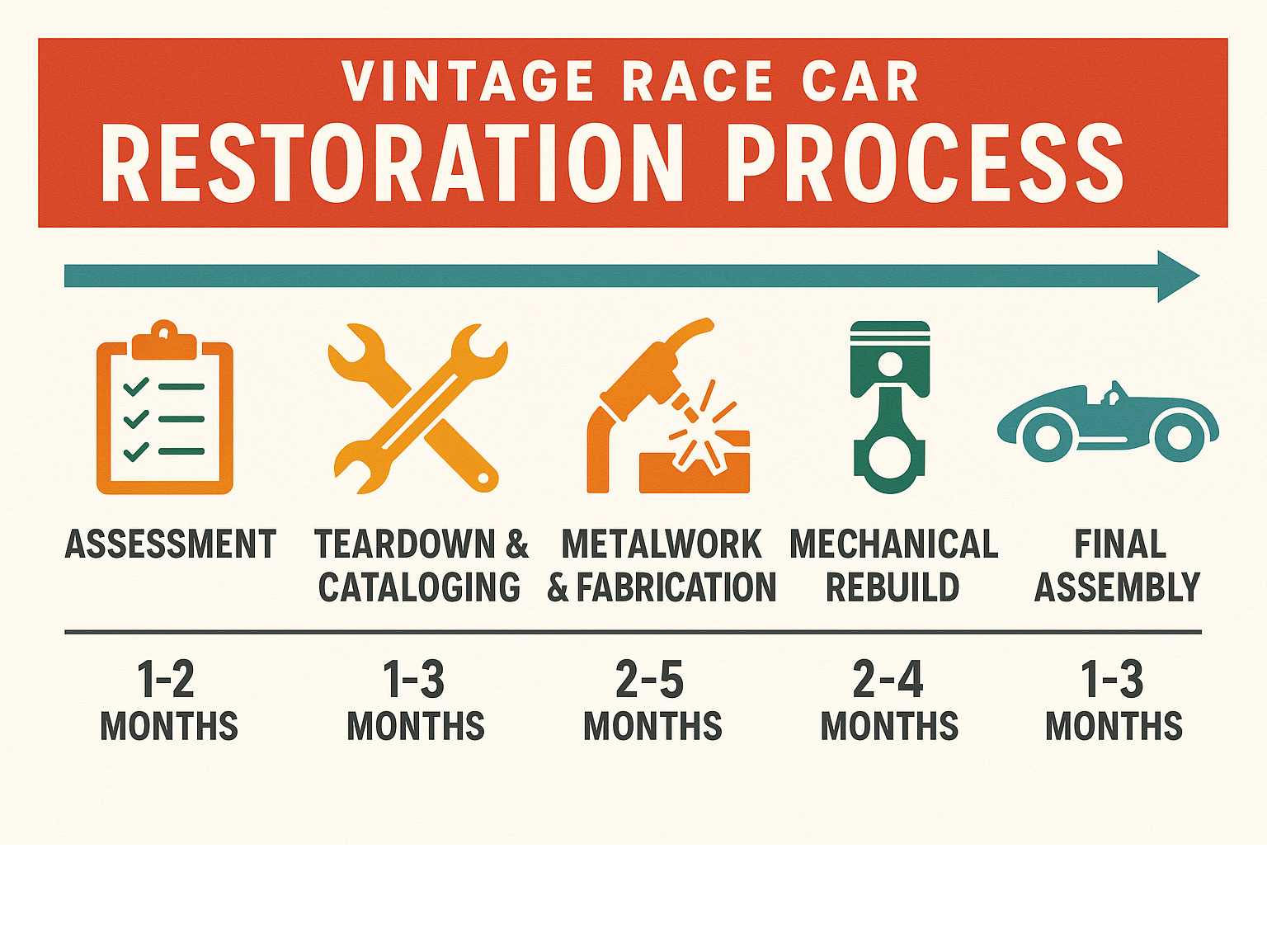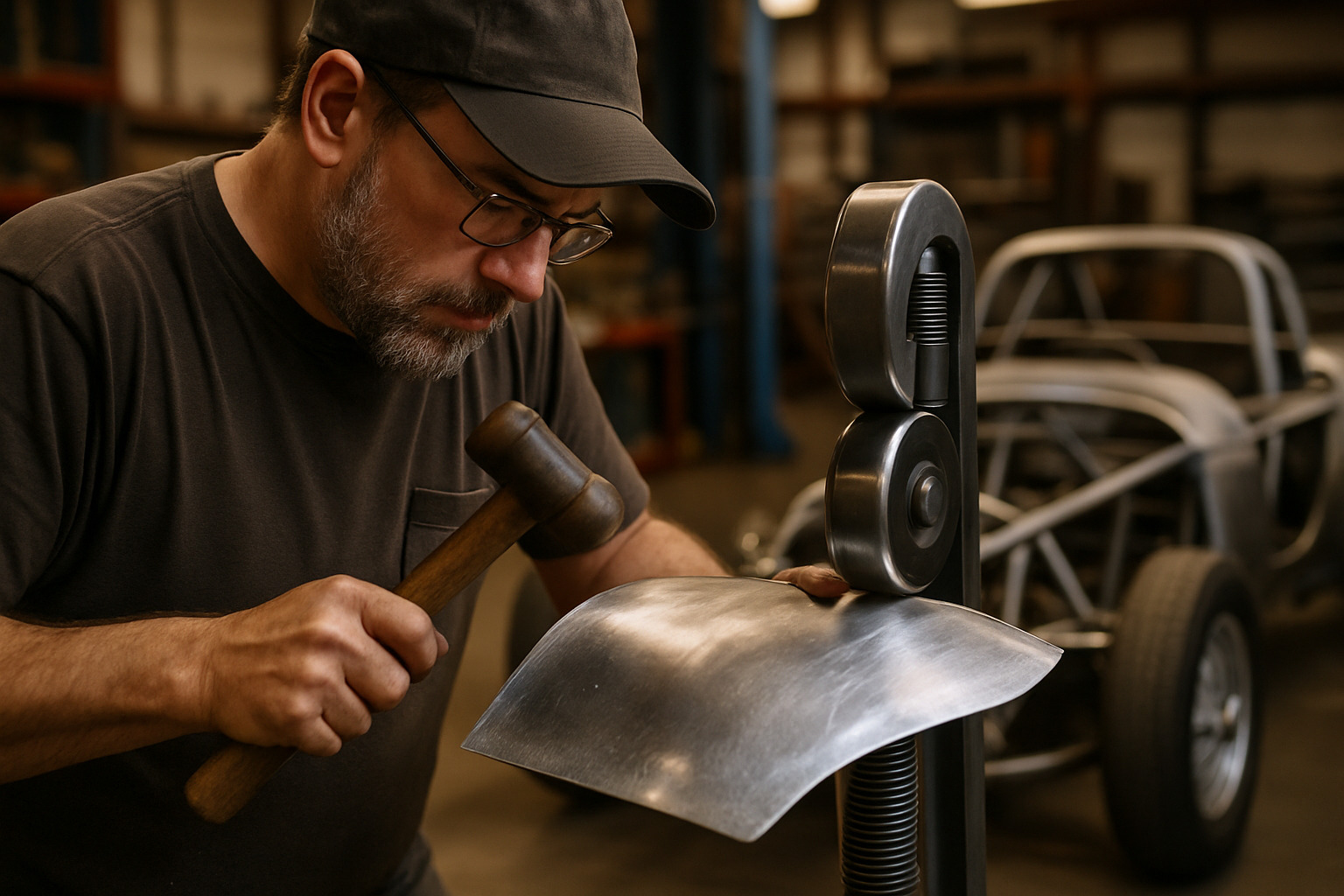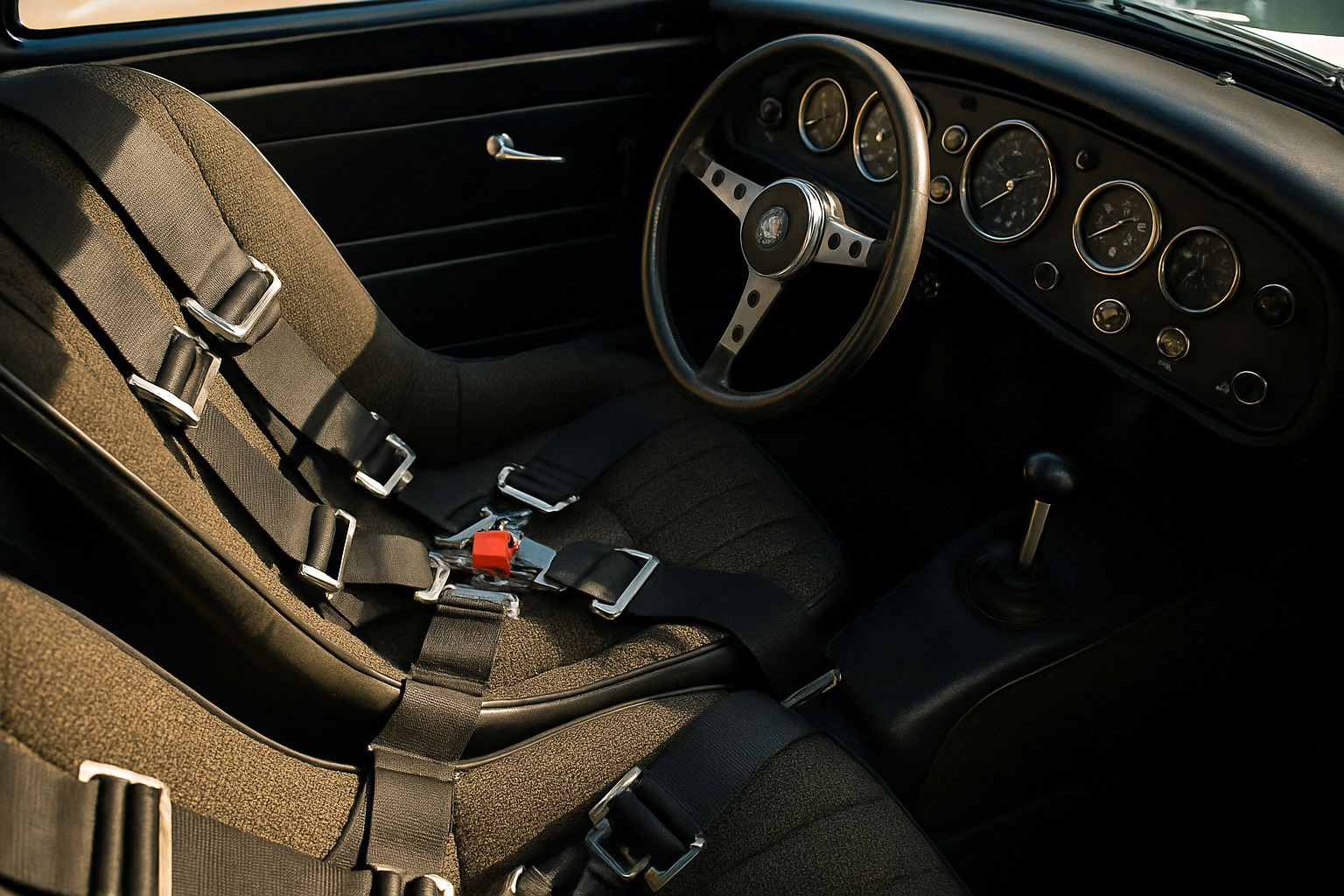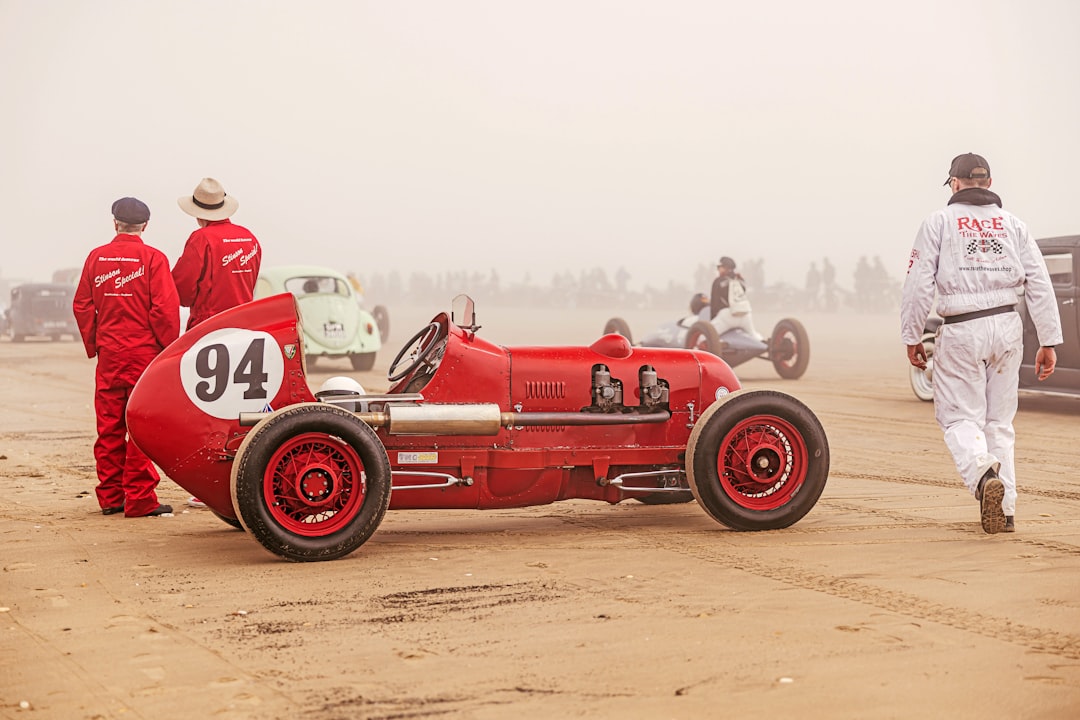Vintage Race Car Restoration: Top 5 Proven Steps for 2025
Why Vintage Race Car Restoration Matters More Than Ever
Vintage race car restoration brings legendary racing machines back to life, preserving motorsport history while creating investment-grade collector vehicles. Unlike standard car restoration, these projects require specialized knowledge of racing regulations, period-correct specifications, and authentic competition components.
Quick Overview: What Vintage Race Car Restoration Involves
- Timeline: 1,000-3,000 labor hours over 6-18 months
- Cost Range: $100,000-$500,000 for concours-quality work
- Key Steps: Documentation, teardown, metalwork, mechanical rebuild, paint/assembly
- Parts Challenge: 70% require custom fabrication due to scarcity
- Expertise Needed: Racing history knowledge, specialized tooling, authentic materials
The vintage car restoration market now exceeds $1.7 billion annually, driven by collector demand and over 50 major vintage racing events across the U.S. each year. These aren’t just garage queens – they’re living history that can appreciate 20-50% in value after a quality restoration.
What makes this different from restoring your grandfather’s Mustang? Racing pedigree matters. Every component needs to match the car’s competition history. A 1965 Shelby Cobra that raced at Sebring requires different treatment than one that sat in a showroom.

Similar topics to vintage race car restoration:
– race car driver career path
– race car suspension tuning
– race car telemetry systems
What Sets Vintage Race Car Restoration Apart?
Restoring a vintage race car is like bringing back a legendary athlete from their prime. Every component needs to be exactly right – because these machines were built for one thing: winning.
When you’re working on vintage race car restoration, you’re preserving motorsport history that was engineered to push absolute limits. A 1960s Trans-Am Mustang might look like its street cousin, but underneath, everything was different – engine internals, suspension geometry, and body modifications were all about going faster.
Understanding this Sports Car Racing History context is crucial for authentic restoration work.
Homologation rules forced manufacturers to build minimum numbers of road cars just to qualify their racing versions for competition. A Porsche 911 Carrera RSR looks similar to a street 911, but those fender flares, suspension pickup points, and engine specs tell a completely different story.
Modern safety regulations add complexity. Today’s vintage racing requires safety equipment that didn’t exist when these cars first hit the track. The art lies in integrating roll cages, fire suppression systems, and modern safety belts while keeping the car’s authentic soul intact.
Racing DNA vs Street Car Revival
What separates a $50,000 Cobra replica from a $5 million original? Pedigree documentation. We’re talking about provenance papers, period photographs, and chassis stampings that prove a car’s racing heritage.
Period-correct specifications matter to serious collectors. That 1970s carburetor might make your 1960s engine run better, but collectors will spot that anachronism immediately. Concours judges will deduct points without mercy.
Chassis stamping verification requires detective-level skills. Original racing chassis often carry subtle marks, welds, or modifications that tell their competition story. These details are nearly impossible to fake convincingly.
Key Eras & Categories
Pre-war Grand Prix cars from the 1920s through 1939 represent motorsport’s pioneering spirit. These hand-built machines require knowledge of early metallurgy and mechanical systems that existed before hydraulic brakes were common.
1950s sports racers like the Porsche 550 Spyder established the blueprint for modern sports car racing. These machines bridge pre-war craftsmanship with emerging modern engineering principles.
1960s Trans-Am and Can-Am cars represent the golden age of American road racing. These purpose-built machines pushed every boundary, often using experimental materials and techniques.
Group C prototypes from the 1980s brought high-tech aerodynamics, ground effects, and turbocharging. Restoring these cars means understanding complex systems that were cutting-edge technology.
Modern historic racing series have expanded “vintage” to include cars from the 1990s and 2000s, creating new restoration opportunities.
Mastering Vintage Race Car Restoration: Step-by-Step Roadmap
Vintage race car restoration demands 1,000 to 3,000 labor hours spread across 6 to 18 months with experienced professionals. The process requires a systematic approach that can’t be shortcut.
Specialist tooling separates professionals from weekend warriors. You can’t hand-form aluminum body panels with basic garage tools. Metal fabrication requires English wheels, bead rollers, and forming blocks. Engine rebuilds need period-specific tools and precision measuring equipment.
This is why most successful vintage race car restoration projects happen at dedicated Sports Car Repair Shop facilities rather than home garages.
Quality control checkpoints keep projects on track and prevent expensive mistakes. Professional shops inspect progress at specific intervals, catching problems before they become major headaches.
Initial Assessment & Documentation for vintage race car restoration
Forensic inspection reveals what’s hiding under decades of paint and repairs. We examine paint layers under magnification, use ultrasonic gauges to check metal thickness, and snake borescopes into engines to see internal damage without teardown.
Photo cataloging creates your restoration bible. Every component, marking, and detail gets documented before anyone touches a wrench. These photos become lifesavers during reassembly.
Provenance files tell the car’s story and establish authenticity. Original build sheets, race entry forms, and period photographs help determine what the car should look like when finished.
Tear-Down & Cataloging
Bag-and-tag methodology prevents mystery parts scattered around the shop. Every bolt, washer, and bracket gets photographed in place, then stored in labeled containers with detailed notes.
Non-destructive removal preserves original components whenever possible. Heat, penetrating oil, and patience replace hammers and cutting tools. Even corroded original fasteners contain valuable information about specifications and history.
Media blasting strips away decades of paint and corrosion to reveal true condition. Different media types work better for different jobs – glass beads for aluminum, walnut shells for paint removal, or soda blasting for gentle cleaning.
Metal, Body & Chassis Fabrication

Lead-loading represents traditional bodywork techniques standard when these cars were built. Modern body filler didn’t exist in the 1950s and 1960s, so authentic restorations use lead-tin alloys applied with traditional tools and flame.
Jig alignment ensures chassis dimensions match factory specifications. Racing cars often suffered damage during competition careers, and previous repairs might not have maintained proper geometry.
Rust replacement goes beyond patch panels. Structural components require precise fabrication to maintain the car’s strength and handling characteristics.
Powertrain & Mechanical Rebuild
Matching-numbers engines command premium values but present unique challenges. Original racing engines often have non-standard components or period modifications that must be preserved for authenticity.
Period carburetors versus modern internals creates philosophical divisions. Purists insist on original specifications. Pragmatists argue for hidden improvements that maintain appearance while improving function.
Dyno break-in procedures protect rebuilt engines during critical first hours. Racing engines often have tighter tolerances requiring specific break-in procedures to ensure longevity.
Paint, Trim & Final Assembly for vintage race car restoration
Color-code research requires detective work to determine authentic paint schemes. Original racing liveries often changed throughout a car’s competition career.
Iconic graphics and sponsor decals must match period specifications exactly. Authentic restorations use traditional sign-painting techniques or specially manufactured decals that replicate original materials. Understanding Iconic Race Car Liveries helps ensure historical accuracy.

Final assembly sequence matters more than most realize. Components must go back together in specific order to avoid interference problems or making other parts inaccessible.
Authenticity, Provenance & Parts Sourcing
Vintage race car restoration gets expensive when finding the right parts. It’s not just about making the car run; it’s about preserving history and protecting your investment.
Factory build sheets are like buried treasure. These documents tell you exactly what came on your car from the factory. Most manufacturers treated racing cars as one-offs and didn’t keep detailed records.
Race-entry logs show which events the car entered, what modifications were required, and sometimes lap times. They’re goldmines for understanding which parts belong and which were added later.
70% of parts need custom fabrication. You can’t order vintage racing components from a catalog. That Weber carburetor throat might be cracked, magnesium wheels could be beyond repair, and original brake pads from 1965 don’t exist.
Specialist networks become your lifeline. The vintage racing world is small, and everyone knows everyone. The guy who restored the winning Sebring car might know where to find the exact intake manifold you need.
If you’re dealing with an imported car, the paperwork trail becomes complex. 5 Tips for Importing a Collector Car covers essential steps.

Provenance Papers That Add Value
FIA Historic Technical Passports are the gold standard for vintage race cars. These official documents prove your car’s authenticity and give access to premier racing events worldwide. Getting an HTP requires extensive documentation but can add six figures to your car’s value.
Original bills of sale are authentication gold. That yellowed dealer invoice from 1967 often lists factory options, delivery dates, and the original buyer’s name. Finding the original invoice can increase a car’s value by $200,000.
Period photographs from racing events are worth hunting down. That grainy shot from Road & Track might show exactly how your car looked at Watkins Glen in 1969.
Hunting Rare & Original Parts
Swap meets are where real treasure hunting happens. You’ll wade through tables of rusty bolts, but occasionally you’ll spot something incredible. The key is knowing what you’re looking for and building relationships with regular vendors.
Donor cars present tough ethical choices. Should you strip a rough but complete car to restore a better example? Sometimes it’s the only way to save a historically significant car.
CAD-CAM reproductions represent the future of impossible-to-find parts. Modern scanning and manufacturing can recreate components with precision exceeding original factory tolerances.
Documenting the Restoration Journey
Build books become part of your car’s permanent record. Think of them as the restoration’s autobiography – before and after photos, parts sources, work procedures, and any deviations from original specs.
Media coverage during restoration creates marketing materials and preserves your car’s story. Having your restoration featured in a major publication impresses other collectors.
Professional appraisals protect your investment and provide documentation for insurance. Get appraisals updated as work progresses – a car worth $150,000 in rough condition might be worth $400,000 after concours-quality restoration.
Budget, Timeline & Choosing the Right Shop
The $100,000-$500,000 range for concours-quality vintage race car restoration reflects the real cost of bringing a racing legend back to life properly. Everything takes longer than expected, and nothing is available at the local parts store.
The 6-18 month queues at top restoration shops tell you something important. The best craftsmen are booked solid because word travels fast in the vintage racing community.
Skill specialties make all the difference in choosing the right shop. Some excel at hand-forming aluminum but struggle with complex mechanical systems. Others can rebuild any engine but their paint work looks amateur.
Watch for red flags that signal trouble. Shops that promise unrealistic timelines, won’t provide customer references, or can’t show similar completed projects are best avoided.
Understanding where your finished car will appear helps set priorities. Classic Car Gatherings showcase the quality level expected in today’s vintage racing scene.
| Restoration Approach | DIY Cost Range | Professional Cost Range | Time Investment | Quality Level |
|---|---|---|---|---|
| Basic Mechanical Refresh | $15,000-$35,000 | $45,000-$85,000 | 300-600 hours | Track-ready |
| Complete Ground-Up | $40,000-$120,000 | $150,000-$350,000 | 1,500-2,500 hours | Concours-quality |
| Concours Show Winner | $80,000-$200,000 | $250,000-$500,000+ | 2,000-3,000+ hours | Museum-quality |
Estimating Hours & Costs
Labor calculators help with initial budgeting, but vintage race cars break normal rules. Standard restoration formulas assume you can buy replacement parts and follow established procedures. Racing cars laugh at those assumptions.
Parts scarcity multipliers can turn a $50 part into a $500 fabrication project overnight. We’ve seen simple brake lines cost $200 each because they required custom fittings and period-correct materials. Budget at least 30% contingency for surprises.
Vetting Restoration Specialists
Portfolio reviews reveal more than fancy websites. Ask to see cars similar to yours in complexity and value. Pay attention to how authentically they’ve reproduced period details.
Customer references provide the real story about working with a particular shop. Previous customers will tell you about communication during the project, how cost overruns were handled, and whether the finished car met expectations.
Shop visit checklists help you evaluate capabilities systematically. Look for proper tooling, organized work areas, climate-controlled storage, and evidence of projects similar to yours in progress.
Race vs Show: Safety Upgrades & Performance Tuning
Vintage race car restoration walks a tightrope between historical accuracy and modern racing safety. You’re upgrading a 1960s machine with modern safety while keeping it looking exactly the same.
FIA roll cages represent the gold standard for vintage racing safety. These structures must meet specific dimensional and material requirements while looking like they belong in the car. The best installations are works of art.
Modern fire systems and fuel cells present their own puzzle. Today’s safety equipment can save your life, but bright red fire bottles and modern fuel cells stick out in an authentic 1950s cockpit. The challenge is integrating maximum protection with minimal visual impact.
Period-legal tweaks offer smart compromise between performance and authenticity. The key is understanding what modifications were actually available during your car’s original competition era.
Lap-time data from period racing creates fascinating benchmarks. We’ve seen owners use modern data acquisition to verify their restored Cobra runs similar times to what Dan Gurney posted at Riverside in 1964.
Understanding the Famous Racing Circuits where these cars originally competed helps inform smart restoration decisions about gear ratios, suspension setup, and aerodynamic details.

Building for Track Day Reliability
Cooling modifications address harsh reality – vintage racers often competed in different conditions than today’s events. A 1960s sports car might have run 30-minute sprints in cooler weather, but modern vintage events can mean hour-long sessions in 90-degree heat.
Brake compounds and pad materials have improved dramatically. Modern friction materials provide significantly better stopping power and fade resistance while looking identical to original components.
Spares packages separate experienced vintage racers from newcomers. Smart owners carry comprehensive inventories of common failure items – fuel pumps, ignition components, belts, and hoses.
Concours Versus Competition Standards
Paint thickness limits at concours events can catch restoration shops off guard. Show cars often receive multiple coats that create stunning depth, but some judges actually measure paint thickness and penalize cars exceeding period-correct specifications.
Hidden upgrades represent the art of invisible improvement. Internal engine modifications, upgraded electrical systems, and improved suspension components can be concealed while maintaining authentic appearance.
Judge scoring versus scrutineer inspection represents completely different evaluation criteria. Concours judges examine paint finish and interior details with magnifying glasses. Racing scrutineers focus on safety equipment and rule compliance.
Frequently Asked Questions about Vintage Race Car Restoration
How long does a full restoration really take?
18 to 36 months from the day your car rolls into the shop until you’re turning the key for the first time. That timeline assumes everything goes reasonably well – no major surprises hiding under decades of previous “repairs.”
Professional restoration shops juggle multiple projects simultaneously, which works in your favor. While waiting for your custom pistons to arrive from Germany, they’re making progress on bodywork.
Parts availability drives everything. A Porsche 356 restoration might take 18 months because parts are relatively available. That timeline could stretch to three years for a rare Italian prototype where every component needs detective work.
Where do professionals find impossible-to-source parts?
The vintage racing community operates like a secret society. Relationships matter more than money when hunting truly rare components. The shop that’s been restoring Ferraris for 30 years has connections you can’t Google.
Specialist networks form the backbone of parts sourcing. These are decades-old relationships between restorers, collectors, and parts specialists worldwide. A shop in California might know a collector in Switzerland who has the exact carburetor you need.
Modern manufacturing fills gaps where originals don’t exist. 3D scanning and CNC machining can recreate complex components from damaged originals or detailed photographs.
Donor cars present difficult decisions. Breaking up one car to restore another raises ethical questions, especially when both have historical significance.
Can safety upgrades be reversible for concours events?
Smart planning during restoration makes this possible, but requires thinking ahead. The best safety modifications hide in plain sight or can be temporarily removed for show events.
Roll cages can use removable padding that transforms their appearance from race-ready to show-friendly. Modern harnesses can be swapped for period-correct lap belts during concours events.
The key is integration during restoration rather than modification afterward. Professional shops can route wiring for modern safety systems inside original harness wrapping and design roll cage attachment points that don’t compromise authentic appearance.
Conclusion
Vintage race car restoration goes beyond turning wrenches and mixing paint. You’re becoming a guardian of motorsport history, preserving the DNA of legendary machines that once thundered around famous circuits.
The financial rewards are real – quality restorations typically appreciate 20-50% or more after completion. But the true value runs deeper. You’re ensuring these mechanical masterpieces continue roaring to life at vintage racing events rather than gathering dust in forgotten garages.
Whether you’re starting to dream about a project or already knee-deep in parts catalogs, understanding this process helps you make smart decisions. The restoration journey isn’t just about the destination – it’s about joining a community of passionate enthusiasts who share your appreciation for racing heritage.
Your restored race car will need ongoing care to maintain peak condition. Our Ultimate Guide to Car Maintenance for 2025: From Basic to Advanced provides detailed guidance to keep your investment running strong for years to come.
At Car News 4 You, we understand that vintage race car restoration represents the perfect marriage of automotive innovation and racing tradition. These projects honor the past while embracing modern craftsmanship and technology.
The first time you fire up that properly restored racing engine, you’ll hear echoes of checkered flags and victory celebrations. When you grip those period-correct controls, you’re touching surfaces that racing legends once commanded. This connection to motorsport history makes every challenging moment worthwhile.
Whether your finished car competes in vintage racing events, wins concours trophies, or provides weekend driving joy, you’ve accomplished something special. You’ve taken a piece of fading history and given it new life for future generations.
Car News 4 You – driving your passion forward.







